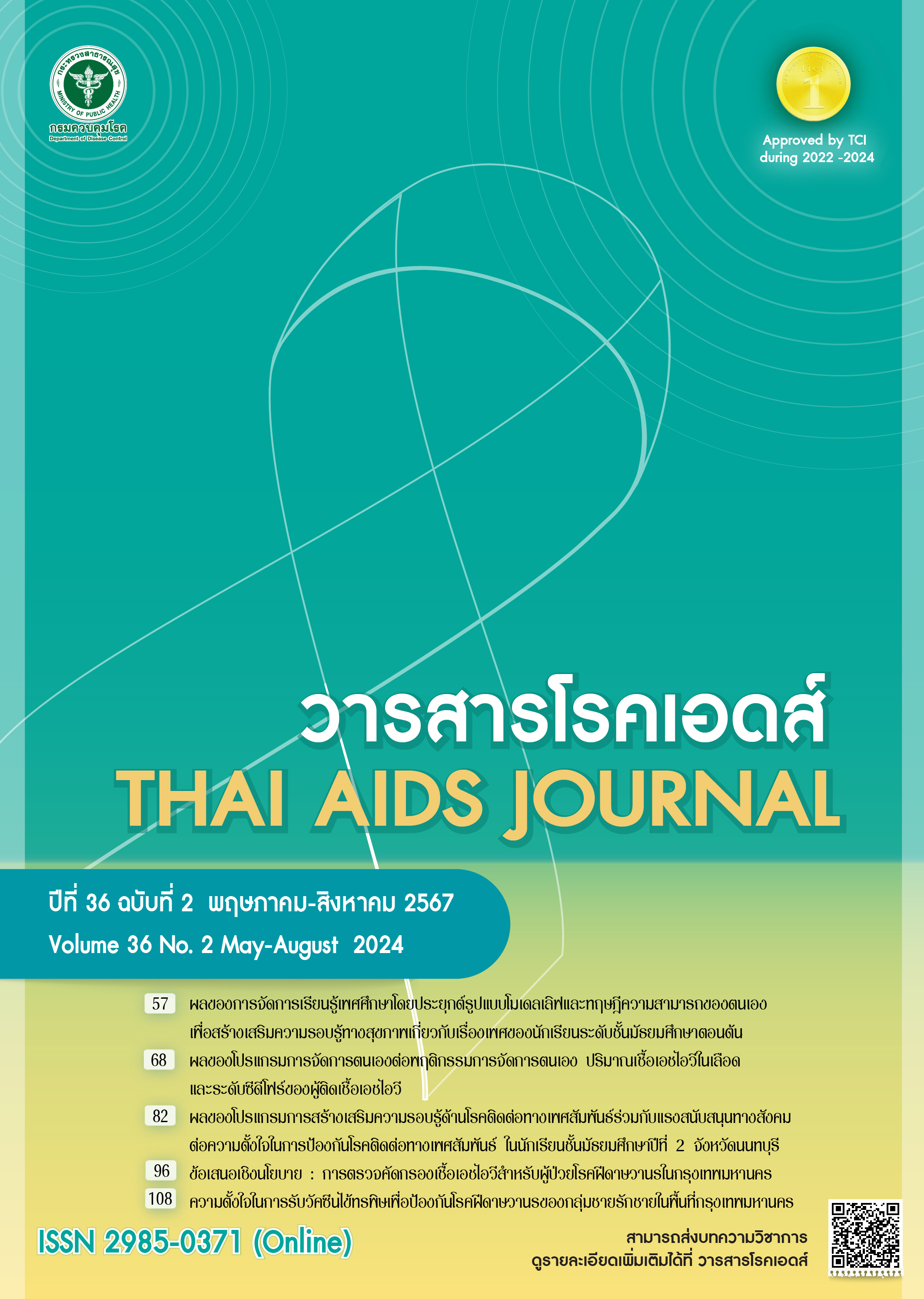ผลของการจัดการเรียนรู้เพศศึกษาโดยประยุกต์รูปแบบโมเดลเลิฟและทฤษฎีความสามารถของตนเองเพื่อสร้างเสริมความรอบรู้ทางสุขภาพเกี่ยวกับเรื่องเพศของนักเรียนระดับชั้นมัธยมศึกษาตอนต้น
DOI:
https://doi.org/10.14456/taj.2024.6คำสำคัญ:
ความรอบรู้ทางสุขภาพเกี่ยวกับเรื่องเพศ, การจัดการเรียนรู้เพศศึกษา, โมเดลเลิฟบทคัดย่อ
การวิจัยนี้มีวัตถุประสงค์เพื่อศึกษาผลของการจัดการเรียนรู้เรื่องเพศศึกษาโดยประยุกต์รูปแบบโมเดลเลิฟและทฤษฎีความสามารถของตนเองเพื่อสร้างเสริมความรอบรู้ทางสุขภาพเกี่ยวกับเรื่องเพศ ของนักเรียนระดับชั้นมัธยมศึกษาตอนต้น รูปแบบการวิจัยเป็นวิจัยกึ่งทดลอง (quasi-experimental research) โดยดำเนินการในกลุ่มตัวอย่าง 2 กลุ่ม ทำการวัดก่อนและหลังการทดลอง กลุ่มตัวอย่างคือ นักเรียนระดับชั้นมัธยมศึกษาปีที่ 2 โรงเรียนนวมินทราชินูทิศ หอวัง นนทบุรี ปีการศึกษา 2566 จำนวน 80 คน แบ่งเป็นกลุ่มทดลอง 40 คน และกลุ่มเปรียบเทียบ 40 คน เครื่องมือวิจัยประกอบด้วยรูปแบบการจัดการเรียนรู้เพศศึกษาโดยประยุกต์รูปแบบโมเดลเลิฟ และทฤษฎีความสามารถของตนเองเพื่อสร้างเสริมความรอบรู้ทางสุขภาพเกี่ยวกับเรื่องเพศของนักเรียนระดับชั้นมัธยมศึกษาตอนต้น แบบประเมินความรอบรู้ด้านสุขภาพเกี่ยวกับเรื่องเพศ และแบบสอบถามความพึงพอใจ ดำเนินการทดลองจำนวน 8 ครั้งๆ ละ 50 นาที สัปดาห์ละ 1 ครั้ง รวม 8 สัปดาห์ กลุ่มเปรียบเทียบ เรียนโดยการจัดการเรียนรู้ปกติตามเนื้อหาเรื่องเพศศึกษาในระดับชั้นมัธยมศึกษาปีที่ 2 วิเคราะห์ข้อมูลด้วยค่าร้อยละ ค่าเฉลี่ย ส่วนเบี่ยงเบนมาตรฐาน paired t-test และ independent t-test ผลวิจัยพบว่า หลังการทดลองกลุ่มทดลองมีคะแนนเฉลี่ยความรอบรู้ทางสุขภาพเกี่ยวกับเรื่องเพศสูงกว่าก่อนทดลอง และสูงกว่ากลุ่มเปรียบเทียบอย่างมีนัยสำคัญทางสถิติ (p<0.05) ส่วนระดับความพึงพอใจต่อกิจกรรมการเรียนรู้เพื่อสร้างเสริมความรอบรู้เรื่องเพศที่ประยุกต์รูปแบบโมเดลเลิฟและทฤษฎีความสามารถตนเอง พบว่ากลุ่มทดลองมีความพึงพอใจในระดับมากที่สุด
Downloads
เอกสารอ้างอิง
Bureau of Risk Communication and Health Behavior, Department of Disease Control. Weekly disease forecast no.5/2022 [Internet]. Nonthaburi: Department of Disease Control; 2022. [cited 2023 Jan 23]. Available from: https://ddc.moph.go.th/brc/news.php?news=23335&deptcode=brc&news_views=148 (in Thai)
Bureau of Reproductive Health, Department of Health. Annual report 2022, Bureau of Reproductive Health [Internet]. Nonthaburi: Department of Health; 2022 [cited 2023 Jan 23]. Available from: https://rh.anamai.moph.go.th/th/department-yearly-report/download/?did=212085&id=100907&reload= (in Thai)
Ministry of Education. Basic education core curriculum A.D. 2008. Bangkok: Agricultural Cooperative Federation of Thailand; 2008. (in Thai)
Wattanaburanon A. A manual of LOVE Model application: model for enhancing comprehensive humanization. Bangkok: Odeon Store; 2014. (in Thai)
Bandura A. Social learning theory. New Jersey: Prentice Hall; 1977.
Kerlinger N. Foundations of behavioral research. New York: Holt Rinehart & Winston; 1966.
Chankhaw S. Development of a health and physical education curriculum for buddhist novices at the lower secondary education level in Phrapariyattidhamma schools [dissertation]. Bangkok: Chulalongkorn University; 2015. 354 p. (in Thai)
Piyayothai S, Kaeodumkoeng N, Makkunchorn J, Chaijaraern S, Jaingam B, Khainwaree K. Development of model of skills training activity to enhance health literacy about HIV STIs to promote the use of condom among adolescents and youths. Thai AIDS Journal. 2021;33(3):111-22. (in Thai)
Piyarit R, Isarankura Na Ayudhaya W. Effect of learning management of local curriculum by applying the LOVE model on critical thinking ability and attitude toward local community: a case of Phetchaburi studies subject. An Online Journal of Education [Internet]. 2015 [cited 2002 Jan 23];10(1):161-74. Available from: https://so01.tci-thaijo.org/index.php/OJED/article/view/40484/33409 (in Thai)
Wongpatcharajarus N. Life skills enhancing program base on self-efficacy concept for reducing risky sexual behaviors of junior high school student [dissertation]. Bangkok. Krirk University; 2018. 202 p. (in Thai)
Tanyasiri N. Effects of learning management on sex education by using the LOVE model for comprehensive humanization of lower secondary school students. Srinakharinwirot Academic Journal of Education [Internet]. 2018 [cited 2002 Jan 23];19(1):67-81. Available from: https://ejournals.swu.ac.th/index.php/jedu/article/view/10372/8675 (in Thai)



